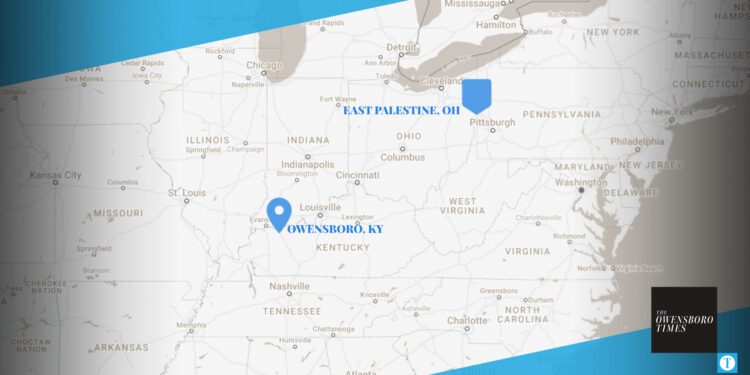Federal, state, and local agencies continue to monitor the water quality of the Ohio River after trace amounts of two industrial chemicals leaked into the river due to a train derailment in northeast Ohio earlier this month. Statements from officials indicate there is no concern about Owensboro’s drinking water being contaminated.
The spill occurred after a train derailed on February 3 in East Palestine, Ohio, near the Pennsylvania border. Some of the train cars were carrying chemicals that reached the Ohio River through a small creek.
According to the U.S. Environmental Protection Agency, responding crews discovered contaminated runoff on two surface water streams: Sulphur Run and Leslie Run. Under Ohio EPA oversight, contractors installed a dam and a water bypass at Sulphur Run to prevent further contamination of downstream waters.
According to the Ohio EPA:
Water quality sampling taken Feb. 10 shows very low levels of two contaminants, butyl acylate and ethyl hexyl acrylate, in Leslie Run which dissipates quickly, and no detects of butyl acrylate in North Fork Little Beaver Creek or Little Beaver Creek. There was a much lower level of ethyl hexyl acrylate found in North Fork Little Beaver Creek. Little Beaver Creek did not have any ethyl hexyl acrylate. No vinyl chloride has been detected in any of these waterways. Sulfur Run flows into Leslie Run, which flows into North Fork Little Beaver Creek, which flows into Little Beaver Creek, which discharges into the Ohio River.
The Ohio EPA also confirmed that while there were still some contaminants in Sulphur Run, that system has been isolated and no additional contaminants would move downstream.
The Ohio River Valley Water Sanitation Commission (ORSANCO) crews have been sampling the areas involved and continue to monitor along the Ohio River. ORSANCO operates monitoring programs to check for pollutants and toxins that may interfere with specific uses of the river.
Tiffany Kavalec, chief of the division of surface water for the Ohio EPA, spoke during a press conference Tuesday afternoon, saying numerous agencies are working to track the contaminants and that anything that did make it into the river would not cause concern for drinking water.
“The Ohio River is very large, and it’s a water body that’s able to dilute the pollutants pretty quickly,” she said. “ORSANCO’s tracking allows for potential closing of drinking water intakes to allow the majority of the chemicals to pass. This strategy along with drinking water treatment … are both effective at addressing these contaminants and helps ensure the safety of the drinking water supplies, so we’re pretty confident that these low levels are not getting passed on to the customers.”
Agencies along the Ohio River have released statements indicating that the further away from the spill, the less likely any contaminants will even be detectable because they will have been diluted by that point of the river.
Greater Cincinnati Water Works (GCWW), which is a member of ORSANCO, issued a statement saying, “The spill happened nearly 300 miles from Cincinnati, but GCWW is part of a network of water utilities that constantly monitor the Ohio River and its tributaries. … During the past few days, our scientists have looked at the size and location of the spill and calculated the travel time of the spill’s plume to reach Cincinnati. This is an advantage of the Ohio River, as its large size helps with diluting a spill, making it easier to treat.”
Louisville Water Company issued a nearly identical statement, more directly starting with the message that, “Based on the current data, we do not believe the spill on the Ohio River in northeast Ohio poses a risk to the quality of our drinking water. Your water is safe to drink.”
According to Louisville’s WVXU, “Louisville Water Company Quality Manager Chris Bobay said the plume was still hundreds of miles upriver, and doesn’t expect that the utility will even be able to detect it by the time it reaches Louisville. WVKU also reported that Kentucky Energy and Environment spokesperson John Mura said ORSANCO has found levels of butyl acrylate well below those that would pose a health concern to people who would drink the water.
Owensboro-Daviess County has two main primary water utility providers. Owensboro Times reached out to the Daviess County Water District for comment but that call went unreturned.
Owensboro Municipal Utilities spokesperson Sonya Dixon noted that their water source isn’t the Ohio River anyway, but is instead a deep underground aquifer on the northeast side of Owensboro. Water is pumped from wells that tap into this water supply. The water from each well is transported through a central gathering line and piped to a water treatment plant.
“We do not anticipate any issues related to our drinking water,” Dixon said. “Our water is taken from an underground aquifer. We continually test and monitor our drinking water to ensure the safety of our customer-owners.”
And further down the Ohio River, the Evansville Water and Sewer Utility issued a statement saying, “There is a slim chance that we will detect contamination from this spill at our site because our drinking water intake structure is around 700 river miles away from the spill,” but the utility is “continuously testing and staying vigilant of the river conditions.”



